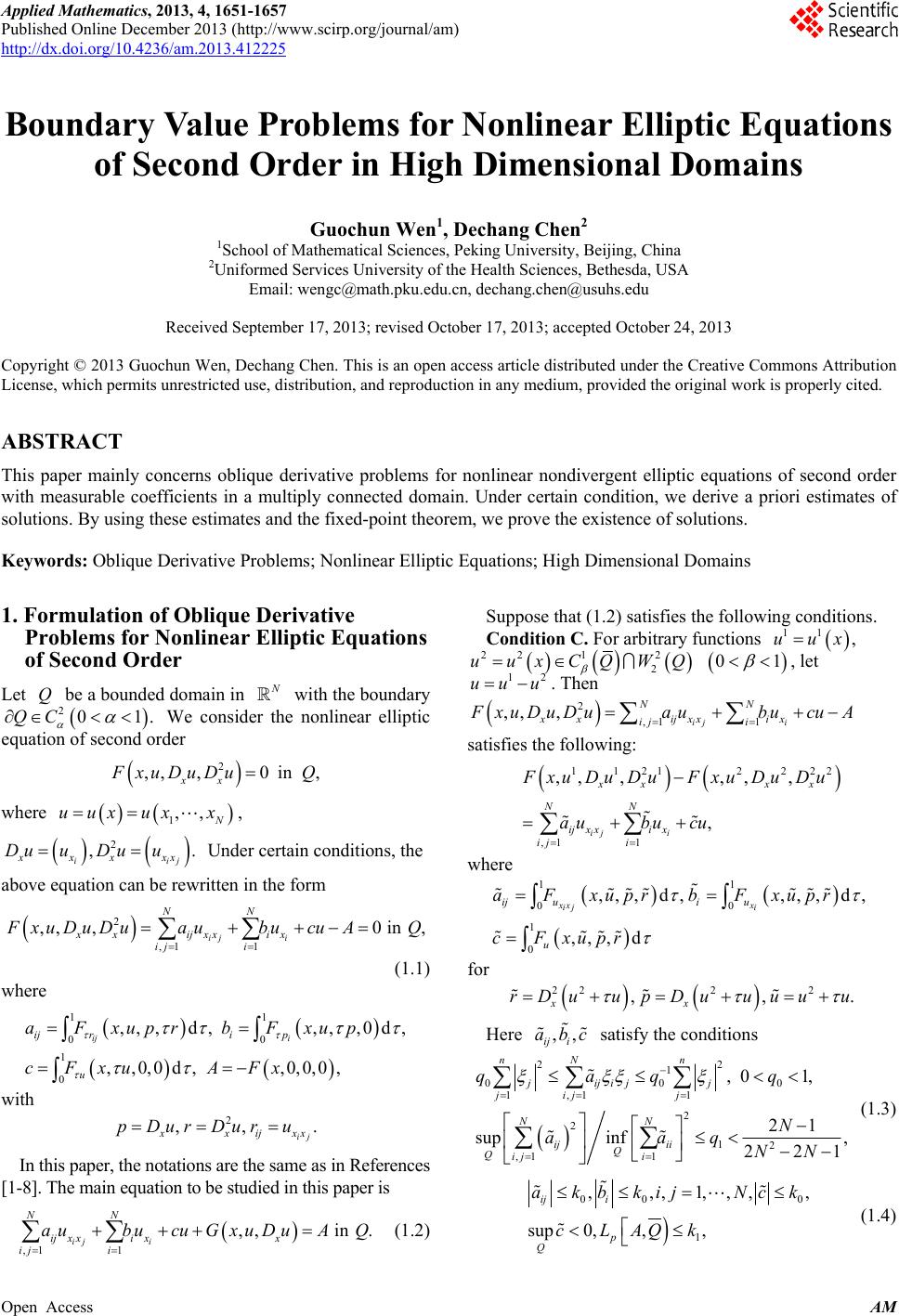 Applied Mathematics, 2013, 4, 1651-1657 Published Online December 2013 (http://www.scirp.org/journal/am) http://dx.doi.org/10.4236/am.2013.412225 Open Access AM Boundary Value Problems for Nonlinear Elliptic Equations of Second Order in High Dimensional Domains Guochun Wen1, Dechang Chen2 1School of Mathematical Sciences, Peking University, Beijing, China 2Uniformed Services University of the Health Sciences, Bethesda, USA Email: wengc@math.pku.edu.cn, dechang.chen@usuhs.edu Received September 17, 2013; revised October 17, 2013; accepted October 24, 2013 Copyright © 2013 Guochun Wen, Dechang Chen. This is an open access article distributed under the Creative Commons Attribution License, which permits unrestricted use, distribution, and reproduction in any medium, provided the original work is properly cited. ABSTRACT This paper mainly concerns oblique derivative problems for nonlinear nondivergent elliptic equations of second order with measurable coefficients in a multiply connected domain. Under certain condition, we derive a priori estimates of solutions. By using these estimates and the fixed-point theorem, we prove the existence of solutions. Keywords: Oblique Derivative Problems; Nonlinear Elliptic Equations; High Dimensional Domains 1. Formulation of Oblique Derivative Problems for Nonlinear Elliptic Equations of Second Order Let be a bounded domain in Q with the boundary We consider the nonlinear elliptic equation of second order 201 .QC 2 ,,,0in , xx xuDuDu Q where , . Under certain conditions, the 1,, N uux uxx 2 , iij xxxxx uDu uDu above equation can be rewritten in the form 2 ,1 1 ,,,0in , ij i NN xxijxx ix ij i xuDuDuaubucuAQ (1.1) where 11 00 1 0 ,, ,d,,,,0d, ,,0,0 d,,0,0,0 , ij i ij rip u aFxuprbFxup cFxu AFx . with 2 ,, ij xij xx pDurDur u In this paper, the notations are the same as in References [1-8]. The main equation to be studied in this paper is ,1 1 ,,in . ij i NN ijx xixx ij i aubucuG xuDuAQ (1.2) Suppose that (1.2) satisfies the following conditions. Condition C. For arbitrary functions 11,uux 22 12 2 uuxCQWQ , let 01 1 uu u 2 . Then 2 ,1 1 ,, ,ij i xxijxx ix ij i NN xuDuDuaubucuA satisfies the following: 11212 222 ,1 1 ,, ,,,, , ij i xxx x NN ijxxix ij i xu Du DuFxuDuDu aubu cu where 11 00 1 0 ,, ,d,,, ,d, ,, ,d xx x ij i ij ui u u aFxuprbFxupr cFxupr for 222 2 ,, xx rDuupDuuuuu. Here satisfy the conditions ,, ij i abc 22 1 00 1,11 2 2 12 ,1 1 ,0 1, 21 inf , sup 22 0 1 n jijij j jij j NN ij ii Q Qiji qaq q N aaq NN nN (1.3) 00 1 ,,,1,,, sup 0,,, ij i p Q akbkij Nck cLAQk 0 , (1.4) 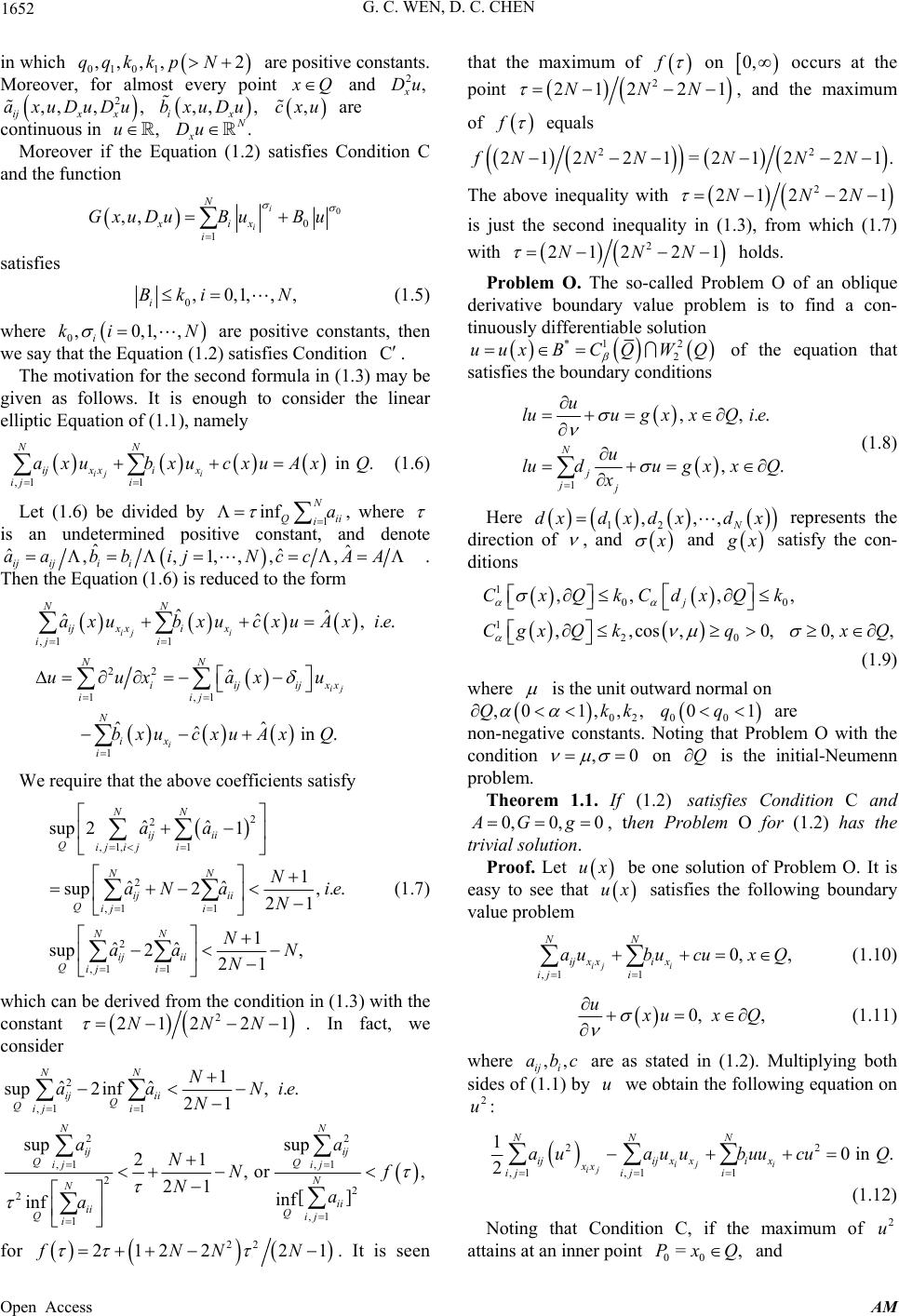 G. C. WEN, D. C. CHEN 1652 in which are positive constants. Moreover, for almost every point 0101 ,,,,2qqkkp N Q ,cxu and ij x are continuous in 2, x Du 2 , , x uDu ,, ix bxuDu ,u. ,,axuD , x Du Moreover if the Equation (1.2) satisfies Condition C and the function 0 0 1 ,, i i N xix i GxuDu Bu Bu satisfies 0,0,1,, i Bki N, (1.5) where are positive constants, then we say that the Equation (1.2) satisfies Condition 0,0,1,, i ki N C . The motivation for the second formula in (1.3) may be given as follows. It is enough to consider the linear elliptic Equation of (1.1), namely ,1 1 in . ij i NN ijx xix ij i axubxu cxuAxQ (1.6) Let (1.6) be divided by 1i i i, where inf N Q a is an undetermined positive constant, and denote ˆ ,, ,aabbijNccAA ˆ ˆˆ 1,,, ijiji i. Then the Equation (1.6) is reduced to the form ,1 1 22 1,1 1 ˆˆ ˆˆ ,.. ˆ ˆˆ ˆin . ij i ij i NN ijx xix ij i NN iijijxx iij N ix i axubxucxuAx ie uux axu bxucxu AxQ We require that the above coefficients satisfy 2 2 ,1,1 2 ,1 1 2 ,11 ˆˆ sup 21 1 ˆˆ sup2,.. 21 1 ˆˆ sup 2, 21 NN ij ii Qiji ji NN ij ii Qiji NN ij ii Qij i aa N aN aie N N aa N N (1.7) which can be derived from the condition in (1.3) with the constant 2 212 21NNN . In fact, we consider 2 ,1 1 22 ,1 ,1 22 2 ,1 1 1 ˆˆ sup2inf,. . 21 sup sup 21 ,or , 21 [] inf inf NN ij ii Q Qij i NN ij ij QQ ij ij N N ii ii Q Qij i N aa Nie N aa NNf Na a for 22 212221fNN N. It is seen that the maximum of f on occurs at the 0, point 2 2 221NNN 1 , and the maximum of f equals 22 2 2=21221.NNN N21fN 1N The above inequality with 2 212 21NNN is just the second inequality in (1.3), from which (1.7) with 22212 1NNN holds. Problem O. The so-called Problem O of an oblique derivative boundary value problem is to find a con- tinuously differentiable solution 2 2 W *1 uux B CQQ of the equation that satisfies the boundary conditions 1 ,,.. ,. N j jj u luugQi e u ludxxQ x x x u g (1.8) Here , N dxd xdx 12 ,,d x represents the direction of , and and x satisfy the con- ditions 1 00 1 20 ,, ,, ,,, 0,0, CxQk xQk Cgx QkqxQ cos j Cd , (1.9) where is the unit outward normal on 02 1,,Qk , ,0 ,k 0 0 0 are non-negative constants. Noting that Problem O with the condition 0qq1 on is the initial-Neumenn problem. Q (1.2) Theorem 1.1. If satisfies Condition C and 0,0, 0AGg , then Problem O for (1.2) has the trivial solution. Proof. Let ux be one solution of Problem O. It is easy to see that ux satisfies the following boundary value problem ,1 0, , ij NN ijx x ij i auux Q 1i i x bu c (1.10) 0, , u uxQ (1.11) where are as stated in (1.2). Multiplying both sides of (1.1) by we obtain the following equation on : ,, ij i abc u 2 u 22 ,1,11 10in. 2ij ij xx auu 00 Px i ij NNN iji x xx ijij i aubuu cuQ , (1.12) Noting that Condition C, if the maximum of attains at an inner point and 2 u = Q Open Access AM 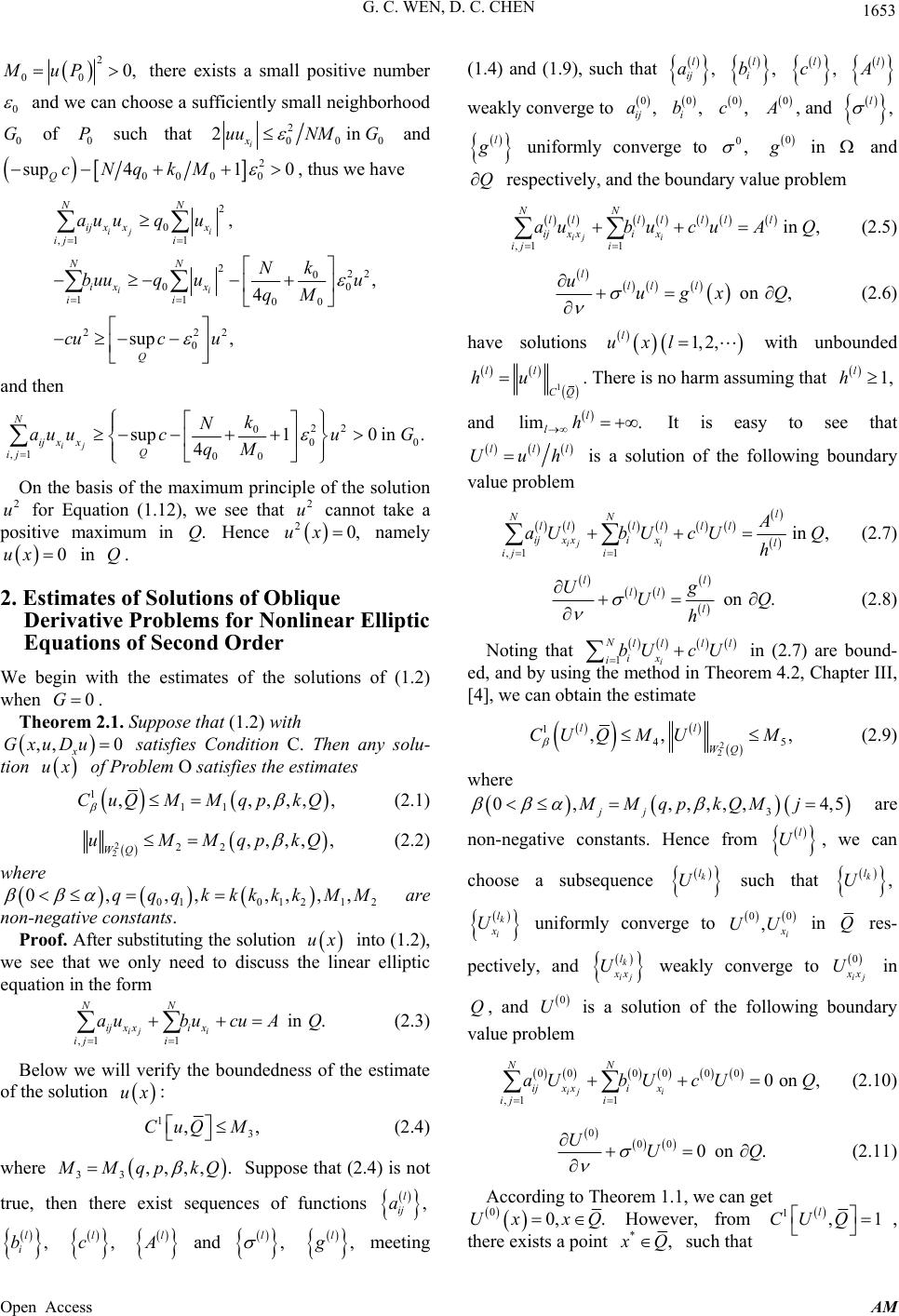 G. C. WEN, D. C. CHEN 1653 2 00 0,MuP there exists a small positive number 0 and we can choose a sufficiently small neighborhood of such that 0 G0 P2 00 2i i x uuNM G 0 n and 2 000 0 sup41 0 QcNqkM , thus we have 2 0 ,1 1 222 0 00 11 00 222 0 , , 4 sup , iji ii NN ij xxx ij i NN ix x ii Q au uqu k N buuq uu qM cuc u and then 22 0 00 ,1 00 sup10in. 4 ij N ij xxQ ij k N au ucuG qM On the basis of the maximum principle of the solution for Equation (1.12), we see that cannot take a positive maximum in Hence namely in Q. 2 u ux 2 u 2 ux .Q 0, 0 2. Estimates of Solutions of Oblique Derivative Problems for Nonlinear Elliptic Equations of Second Order We begin with the estimates of the solutions of (1.2) when . 0G Theorem 2.1. Suppose that (1.2) with satisfies Condition C. Then any solu- tion of Problem O satisfies the estimates ,, 0 x GxuDu ux 1 11 ,,,CuQM Mqp kQ ,,, (2.1) 2 222 ,,,,, WQ uMMqpk Q (2.2) where are non-negative constants. 010121 2 0,,,,,,,qqqkkkkkMM Proof. After substituting the solution into (1.2), we see that we only need to discuss the linear elliptic equation in the form ux ,1 1 in . ij i NN ijx xix ij i aubucu AQ (2.3) Below we will verify the boundedness of the estimate of the solution : ux 1 3 ,CuQ M , (2.4) where 33 ,,,, . Mqp kQ Suppose that (2.4) is not true, then there exist sequences of functions , l ij a , l i b , l c l and , l meeting (1.4) and (1.9), such that , l g , l ij a , l i b , l c l weakly converge to 0, ij a 0, i bc 0, 0 , and , l l uniformly converge to , 0 0 in and Q respectively, and the boundary value problem ,1 ij NN ll ij xx i au 1 ll ix bu i ll cu l Ain,Q ij (2.5) ll l ug on x,Q l u 1, 2,l (2.6) have solutions with unbounded l ux 1 ll CQ hu. There is no harm assuming that and 1, lh lim l lh . It is easy to see that lll Uuh is a solution of the following boundary value problem ,1 1 ll ix bU in ,Q ij NN ll ij xx iji aU icU l ll l A h (2.7) on . ll l Ug U h ll Q (2.8) Noting that 1i i in (2.7) are bound- ed, and by using the method in Theorem 4.2, Chapter III, [4], we can obtain the estimate ll ix bU l N l cU l WQ M 2 2 4 1 CU QU 5 ,,, l M (2.9) where 3 ,,,,kQM U j l 4,50, ,qp jj MM are non-negative constants. Hence from , we can choose a subsequence k l U such that , k l U k i l x U uniformly converge to 0 , 0 i UU in Q res- pectively, and k ij l xx U weakly converge to 0 ij x U in , and is a solution of the following boundary value problem Q 0 U 00 ,1 ij i NN ij xx ij i aU c 00 1 ix bU 000oUn,Q (2.10) 0 00 UU 0on . Q (2.11) According to Theorem 1.1, we can get 00, .Ux xQ However, from 1,1Q l CU , there exists a point *, Q such that Open Access AM 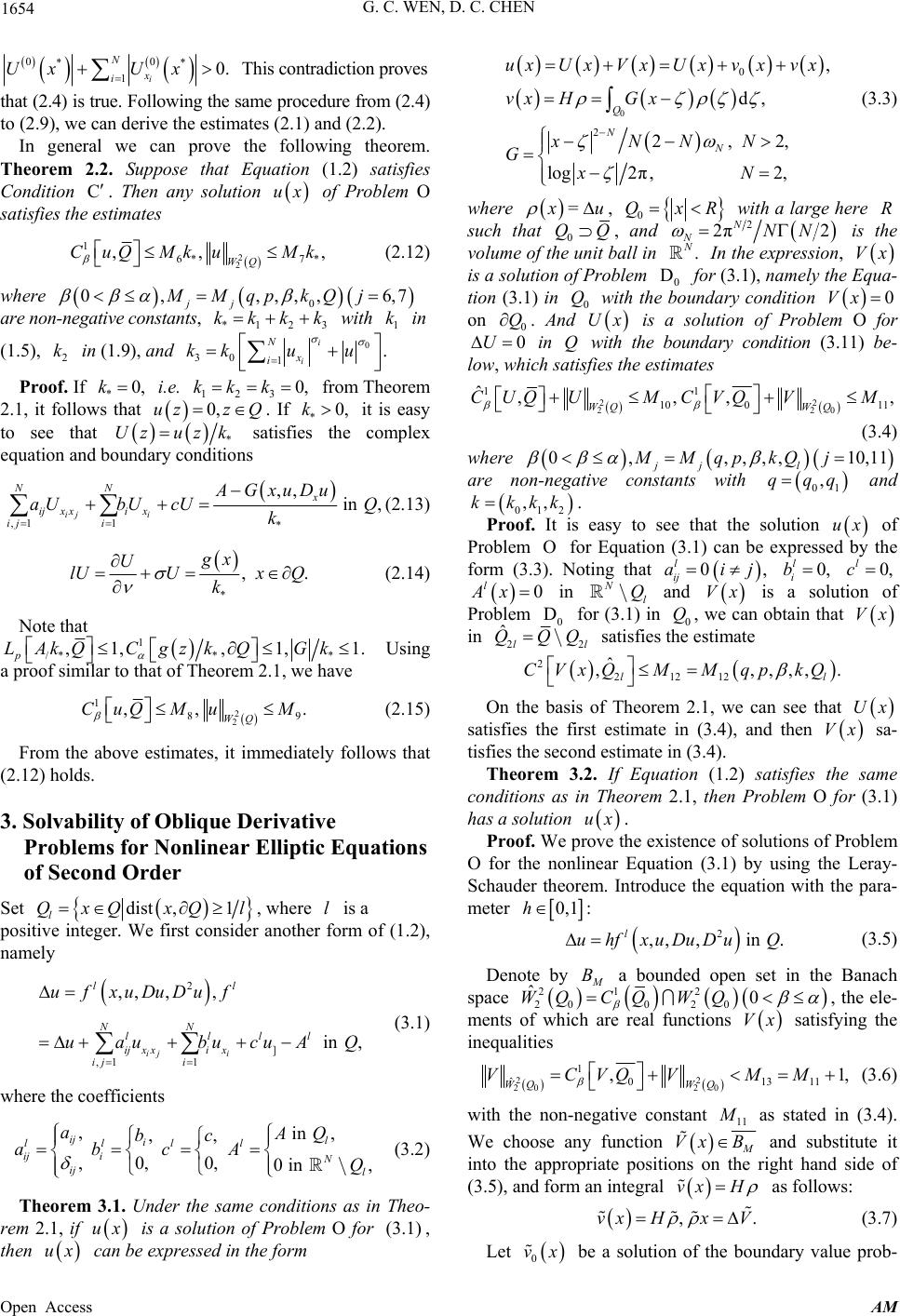 G. C. WEN, D. C. CHEN 1654 00 * 10. i N x i Ux Ux * This contradiction proves that (2.4) is true. Following the same procedure from (2.4) to (2.9), we can derive the estimates (2.1) and (2.2). In general we can prove the following theorem. Theorem 2.2. Suppose that Equation (1.2) satisfies Condition . Then any solution of Problem O satisfies the estimates C ux 2 2 1 6* 7* ,, WQ CuQMkuMk , ,7 (2.12) where 0 0, ,,,,6 jj MMqpkQj kkkkare non-negative constants, *123 k with in 1 (1.5), in (1.9), and 2 k0 30 1. i i N x i kku u Proof. If * i.e. from Theorem 2.1, it follows that . If * it is easy to see that 0,k 123 0,kkk 0, z Q k uz 0, * Uz satisfies the complex equation and boundary conditions uz k ,1 1* ,, in, iji NN x ijx xix iji AGxuDu aUbUcUQ k (2.13) * , gx U lUUx Q k . (2.14) Note that 1 /** * ,1,, 1, p LAkQCgzk QGk 1. Using a proof similar to that of Theorem 2.1, we have 2 2 1 8 ,, WQ CuQMuM 9 . (2.15) From the above estimates, it immediately follows that (2.12) holds. 3. Solvability of Oblique Derivative Problems for Nonlinear Elliptic Equations of Second Order Set dist ,1 l QxQxQ l , where is a positive integer. We first consider another form of (1.2), namely l 2 ] ,11 ,, ,, in , ij i ll NN llll ijx xix ij i ufxuDuDuf uau bucuA Q (3.1) where the coefficients ,in , ,, ,0, 0, 0in , ij l i llll ij iN ij l aAQ bc abcA Q (3.2) Theorem 3.1. Under the same conditions as in Theo- rem 2.1, if is a solution of Problem O for , then can be expressed in the form ux (3.1) ux 0 0 2 , d, 2,2, log 2π,2 Q N N uxUxVxUx vx vx vx HGx xNNN GxN , (3.3) where = u , 0 QxR with a large here such that R 0 QQ , and 2 2π2 N NNN is the volume of the unit ball in . In the expression, Vx is a solution of Problem 0 for (3.1), namely the Equa- tion (3.1) in with the boundary condition D 0 Q Vx 0 on 0 Q . And Ux is a solution of Problem O fo r 0U in with the boundary condition (3.11) be- low, which satisfies th e estimates Q 22 22 11 10 011 ˆ,,, WQ WQ CUQUMCVQVM 0 , (3.4) where 0, ,,,,10, jjl MMqpkQj 01 ,qqq 11 are non-negative constants with and 012 ,,kkkk. Proof. It is easy to see that the solution ux of Problem for Equation (3.1) can be expressed by the form (3.3). Noting that O 0, l ij aij 0, l i b0, l c l Ax 0 in and Nl Q Vx is a solution of Problem for (3.1) in 0 Q, we can obtain that 0 D Vx in 22l Q ˆ ˆl QQ 2 satisfies the estimate 21 212 ,, , ll CVxQMM qpkQ ,,. On the basis of Theorem 2.1, we can see that Ux satisfies the first estimate in (3.4), and then V sa- tisfies the second estimate in (3.4). x Theorem 3.2. If Equation (1.2) satisfies the same conditions as in Theorem 2.1, then Problem O for (3.1) has a solution ux. Proof. We prove the existence of solutions of Problem O for the nonlinear Equation (3.1) by using the Leray- Schauder theorem. Introduce the equation with the para- meter 0,1h: 2 ,,,in . l u hfxuDuDuQ (3.5) Denote by a bounded open set in the Banach space M B 2 ˆ0WQ CQ WQ 21 20020 , the ele- ments of which are real functions satisfying the inequalities Vx 22 20 20 1 ˆ013 ,1 WQ WQ VCVQVMM 11 , (3.6) with the non-negative constant 11 as stated in (3.4). We choose any function Vx B and substitute it into the appropriate positions on the right hand side of (3.5), and form an integral vx H as follows: ,vx HxV . (3.7) Let 0 vx be a solution of the boundary value prob- Open Access AM 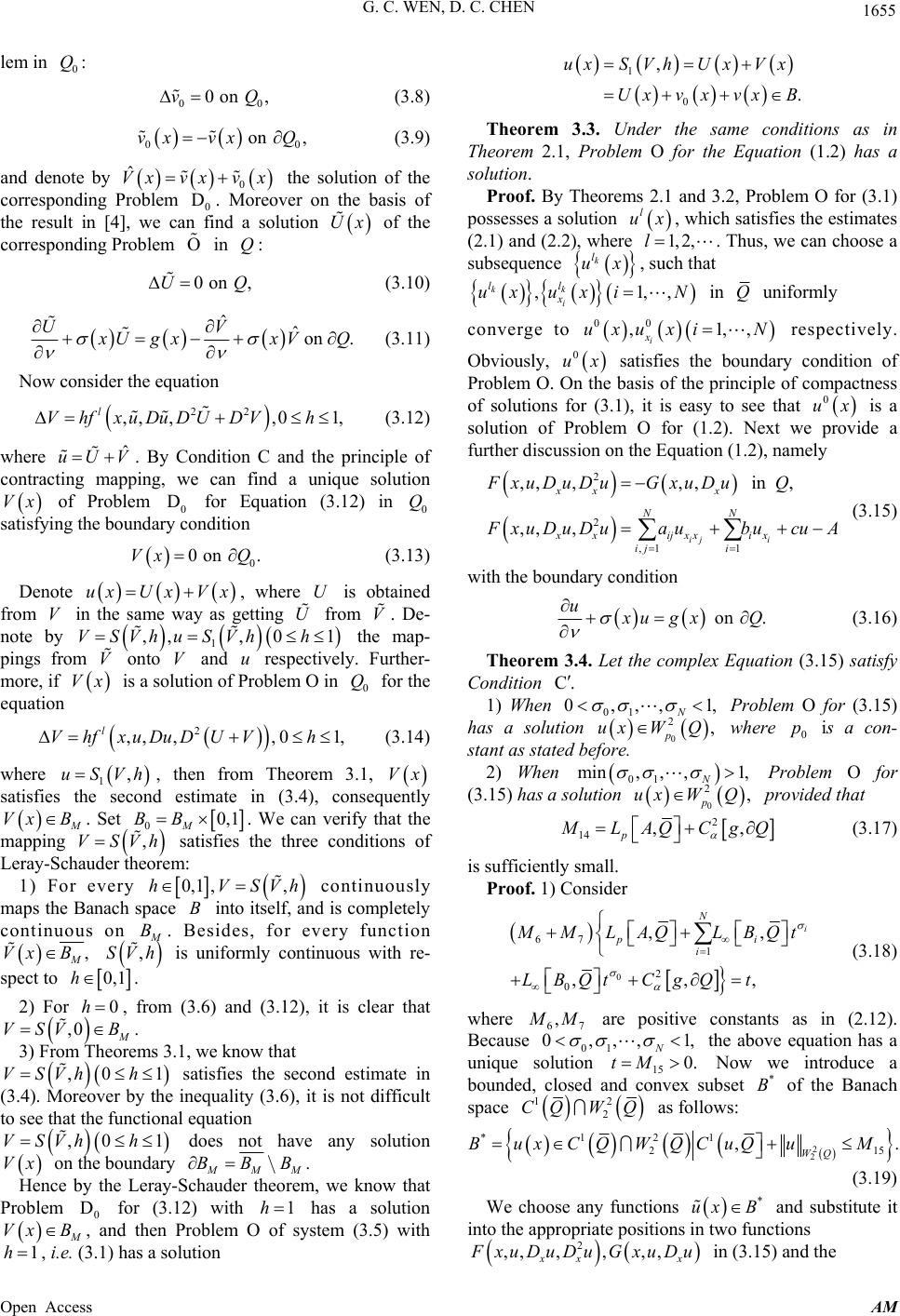 G. C. WEN, D. C. CHEN 1655 lem in : 0 Q 0 0on ,v 0 Q Q (3.8) 00 on ,vx vxQ ˆ (3.9) and denote by the solution of the corresponding Problem 0. Moreover on the basis of the result in [4], we can find a solution of the corresponding Problem in : 0 Vx vxvx D O Q Ux 0on ,U (3.10) ˆˆon . UV UgxxV Q Vh V Vh (3.11) Now consider the equation 22 ,, ,,01, l fxuDuDUDV h (3.12) where . By Condition C and the principle of contracting mapping, we can find a unique solution of Problem 0 for Equation (3.12) in satisfying the boundary condition ˆ uUV Vx D0 Q 0 0on .Vx Q (3.13) Denote , where U is obtained from in the same way as getting from V. De- note by 1 the map- pings from V onto and u respectively. Further- more, if is a solution of Problem O in for the equation uxUx Vx ,,VSVhuS Vh V Vx U 0 0 , 1h Q 2 ,, ,,01, l fxuDuDUV h (3.14) where , then from Theorem 3.1, 1,uSVh Vx satisfies the second estimate in (3.4), consequently VxB. Set 0 ,VSV0,1 M BB h. We can verify that the mapping satisfies the three conditions of Leray-Schauder theorem: 1) For every 0,1 ,,hVSV B h continuously maps the Banach space into itself, and is completely continuous on B. Besides, for every function , Vx B is uniformly continuous with re- SVh , spect to 0,1h. 2) For , from (3.6) and (3.12), it is clear that 0h ,0 VSV B. 3) From Theorems 3.1, we know that satisfies the second estimate in (3.4). Moreover by the inequality (3.6), it is not difficult to see that the functional equation does not have any solution on the boundary ,0 1VSVhh ,0 1VSVhh Vx MM BBB . Hence by the Leray-Schauder theorem, we know that Problem 0 for (3.12) with has a solution D1 h Vx 1hB, and then Problem O of system (3.5) with , i.e. (3.1) has a solution 1 0 , . uxSVhUx Vx Ux vx vxB Theorem 3.3. Under the same conditions as in Theorem 2.1, Problem O for the Equation (1.2) has a solution. Proof. By Theorems 2.1 and 3.2, Problem O for (3.1) possesses a solution l ux 1,l, which satisfies the estimates (2.1) and (2.2), where 2 , . Thus, we can choose a subsequence x k l u, such that x ,1i ,,N kk i ll x ux u in Q uniformly converge to 00 ,1, i x uxuxi N, respectively. Obviously, ux 0 satisfies the boundary condition of Problem O. On the basis of the principle of compactness of solutions for (3.1), it is easy to see that 0 ux is a solution of Problem O for (1.2). Next we provide a further discussion on the Equation (1.2), namely 2 2 ,1 1 ,,,,,in , ,, ,ij i xx x NN xxijxx ix ij i FxuDuDu GxuDuQ xuDuDuaubucuA (3.15) with the boundary condition on . u ugx Q (3.16) Theorem 3.4. Let the complex Equation (3.15) satisfy Condition C. 1) Whe n 01 0,,, N1, Problem O for (3.15) has a solution 0 2, p ux W Q where is a con- stant as stated before. 0 p 2) When 01 min,, ,1, N Problem O for (3.15) has a solution 0 2, p ux W Q provided that 2 14 , p, LAQ CgQ (3.17) is sufficiently small. Proof. 1) Consider 0 67 1 2 0 ,, ,,, i N p ii MLAQLBQt LBQtCgQ t (3.18) where 6 ,7 M 0, are positive constants as in (2.12). Because 01 ,, N1, 0.tM the above equation has a unique solution 15 Now we introduce a bounded, closed and convex subset of the Banach space * B 12 2 CQW Q as follows: 2 2 *121 215 ,. WQ BuxCQWQCuQu M (3.19) We choose any functions and substitute it into the appropriate positions in two functions * ux B x 2 ,, ,,,, xx xuDuDuG xuDu in (3.15) and the Open Access AM  G. C. WEN, D. C. CHEN 1656 boundary condition (3.16), and obtain the following 22 ,, ,,, , ,,,,0in , xx x xx xuDuDuuDuDu GxuDuuDu Q (3.20) on . u ugxQ (3.21) where 0 22 ,1 1 1 0 ,, ,,, ,,,, ,,, , ,, ,,, ,. ij ij i i i N xxij xxxx ij N ixx i N xx ixx i x x xuDuDuuDuDuaxuu uu bxuuucxuu A G xuDuuDuBuDuu BuDuu In accordance with the method in the proof of Theorem 3.2, we can prove that the boundary value problem (3.20), (3.21) has a unique solution ux. Denote by the mapping from ux Tux ux to Noting that ux N . 60 123 1 ,, , i pi x i LbuQCcu Mkkkk , from Theorem 2.2, we have 2 2 0 0 1 2 67 6714 1 0 6714015015 15 1 , ,,, , ,, . i i i WQ p N ix i N i CuQ u MLAQCgDLGQ MMM LBQCuQ LBQCuQ MMM kMkMM (3.23) This shows that maps onto a compact subset in Next, we verify that in is a continuous operator. In fact, we arbitrarily select a sequence in such that T* B T *.B n uz * B *,B 2 2 1 00 ,0 nn WQ Cu uQu un as. (3.24) By Theorem 2.1, we can derive that 2 00 0 22 000000 ,, ,,,, ,, ,,, ,,0as, pnxnxx xx LFxu Du xu DuDu Fxu DuDuuDuDuQn (3.25) in which 12 02 Moreover, from .ux CD WQ 00nn it is clear that is a solution of Problem O for the following equation ,uTuuTu 22 000 22 000000 00 0000 ,, ,,, , ,, ,,, , ,, ,, ,, ,,0in, nxnxnx x xx xx nxn x xx Fxu DuDuuDuDu xuDuDuuDuDu GxuDu uDu GxuDu uDuQ (3.26) 0 00on. nn uu uu Q (3.27) In accordance with the method in the proof of Theo- rem 2.2, we can obtain the estimate 2 2 1 00 160 0 0000 22 000 22 000000 , ,, ,, ,, ,,, ,, ,,,, ,, ,,, ,,, nn WQ pnxnx xx pnxnxnxx xx xx Cu uQu u MLGxuDuuDu GxuDuuDuQ L FxuDuDuuDuDu FxuDuDuuDuDuQ (3.28) in which 1616000 ,,,,. MqpkQ From (2.12) and the above estimate, we obtain 2 2 1 00 ,0 nn WQ Cu uQu u as On the basis of the Schauder fixed-point theorem, there exists a function .n 12 2 uxC QWQ such that .ux Tux It is clear that is a solution of Problem O for the Equation (3.15) and the boundary condition (3.16) with ux , N0 0, 1. 2) Secondly, we discuss the case: 0 min,,1. N tM In this case, (3.18) has the solution 16 provided that 14 in (3.17) is small enough. Consider a closed and convex subset in the Banach space * B 12 2 CQW Q, i.e. 2 2 121 *2 ,. WQ BuxCQWQCuQu M 16 Applying a method similar to the one in (1), we can verify that there exists a solution 12 2 uxC QWQ of Problem O for (3.15) when 01 min,, ,1. N Note: The opinions expressed herein are those of the authors and do not necessarily represent those of the Uniformed Services University of the Health Sciences and the Department of Defense. REFERENCES [1] H. O. Codres, “Über die erste Randwertaufgabe bei qua- silinearen Differentialgleichungen zweiter Ordnung in mehr als zwei Variablen,” Mathematische Annalen, Vol. 131, No. 3, 1956, pp. 278-312. http://dx.doi.org/10.1007/BF01342965 , 0n uu Open Access AM 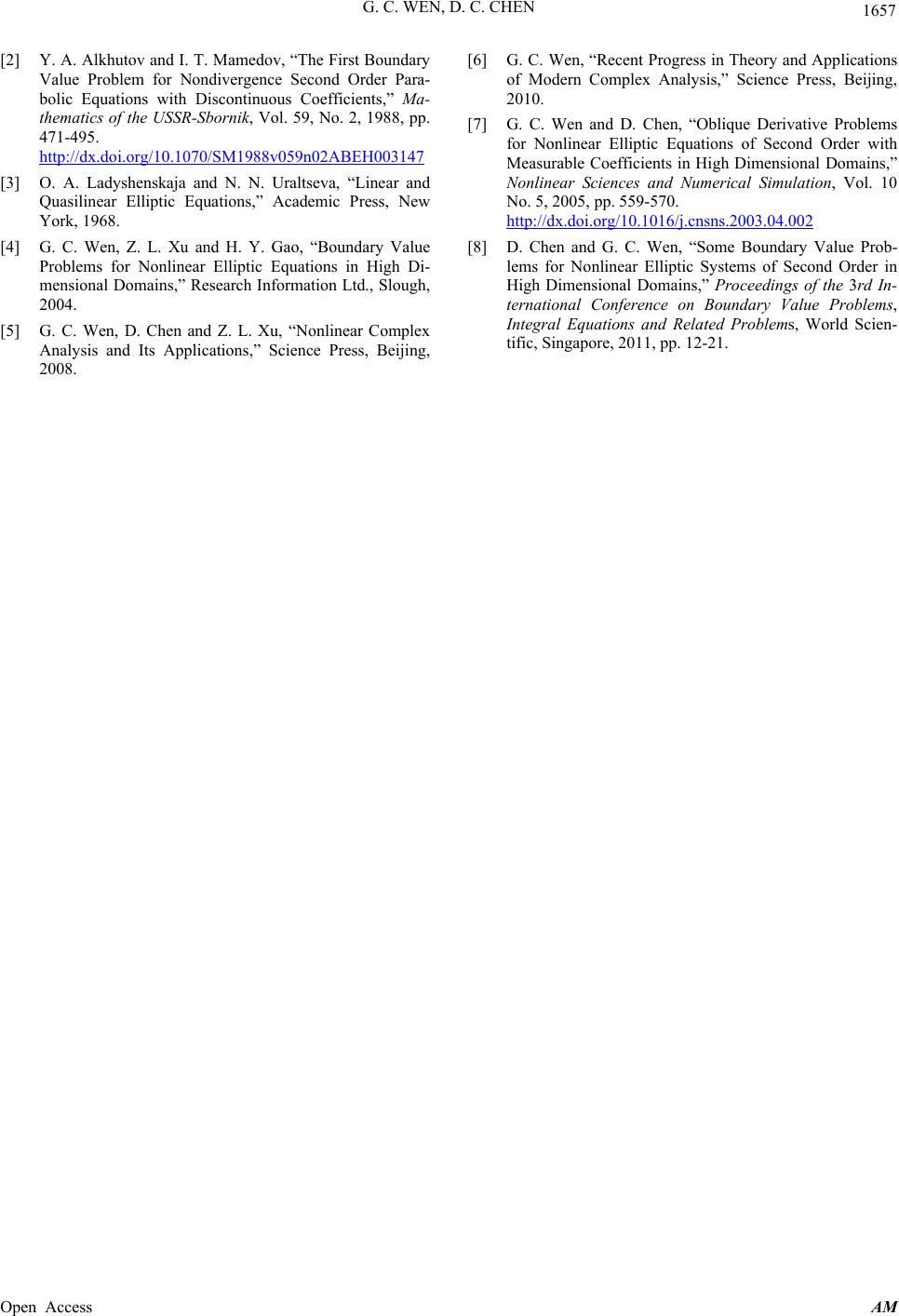 G. C. WEN, D. C. CHEN Open Access AM 1657 [2] Y. A. Alkhutov and I. T. Mamedov, “The First Boundary Value Problem for Nondivergence Second Order Para- bolic Equations with Discontinuous Coefficients,” Ma- thematics of the USSR-Sbornik, Vol. 59, No. 2, 1988, pp. 471-495. http://dx.doi.org/10.1070/SM1988v059n02ABEH003147 [3] O. A. Ladyshenskaja and N. N. Uraltseva, “Linear and Quasilinear Elliptic Equations,” Academic Press, New York, 1968. [4] G. C. Wen, Z. L. Xu and H. Y. Gao, “Boundary Value Problems for Nonlinear Elliptic Equations in High Di- mensional Domains,” Research Information Ltd., Slough, 2004. [5] G. C. Wen, D. Chen and Z. L. Xu, “Nonlinear Complex Analysis and Its Applications,” Science Press, Beijing, 2008. [6] G. C. Wen, “Recent Progress in Theory and Applications of Modern Complex Analysis,” Science Press, Beijing, 2010. [7] G. C. Wen and D. Chen, “Oblique Derivative Problems for Nonlinear Elliptic Equations of Second Order with Measurable Coefficients in High Dimensional Domains,” Nonlinear Sciences and Numerical Simulation, Vol. 10 No. 5, 2005, pp. 559-570. http://dx.doi.org/10.1016/j.cnsns.2003.04.002 [8] D. Chen and G. C. Wen, “Some Boundary Value Prob- lems for Nonlinear Elliptic Systems of Second Order in High Dimensional Domains,” Proceedings of the 3rd In- ternational Conference on Boundary Value Problems, Integral Equations and Related Problems, World Scien- tific, Singapore, 2011, pp. 12-21.
|